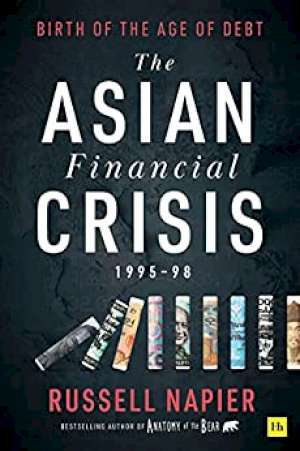28 March 2022
The Asian Financial Crisis
Russell Napier
2021, Harriman House, 388 pages,
ISBN 9780857199140
Reviewer: Ian Harwood

The Asian financial crisis, which began almost twenty five years ago with the devaluation of the Thai baht in July 1997, was at the outset viewed by investors and policy makers in the major developed economies as nothing more serious than “a little local difficulty”. Such complacency, however, was terminally undermined by subsequent developments as foreign capital staged a mass exodus from the region, other regional currencies collapsed, banks and corporates which had gorged themselves on dollar-denominated debt increasingly struggled to survive and the supposed “Asian economic miracle” turned from boom to bust. Indeed, by the autumn of 1998 the region’s import demand had collapsed, hard-pressed companies were exporting deflation to the rest of the world and talk of the risk of a global economic catastrophe akin to the Great Depression of the early 1930s was increasingly rife.
In the event, of course, the world pulled through. The IMF stepped in to administer Draconian “tough love”, the Chinese government adamantly refused to devalue the renminbi, as a quid pro quo for the country’s eventual admission to the WTO in 2001, the Japanese implemented fiscal stimulus and the Fed organised a bail-out of the stricken LTCM hedge fund and then made three successive 25bp cuts in its key policy rate in the autumn of 1998. As a consequence, fear of impending doom abated and the beleaguered Asian economies subsequently experienced impressively robust V-shaped recoveries. And Asian stock markets, which had suffered a precipitous collapse since the Asian Financial Crisis began in the summer of 1997, actually bottomed out in September 1998. The damage to investors’ fortunes, though, had been enormous, with the MSCI Asia ex-Japan stock market index having lost two-thirds of its pre-Crisis value. It would be 2006 before it regained its pre-Crisis high.
Russell Napier, the author of “The Asian Financial Crisis, 1995-98”, is a well-known and highly-respected global macro analyst. He has, furthermore, distinguished himself over the years by establishing the innovative and long-running “A History of Financial Markets” course and also serves as Keeper of the Library of Mistakes, a business and financial history Edinburgh-based institution. Napier has previously penned “Anatomy of the Bear: Lessons from Wall Street’s Four Great Bottoms”, a book which affords many insights into the past behaviour of the world’s largest (and most influential) equity market.
Napier’s latest book is also very much focused upon equity market behaviour but set within the much wider context of how the globally-disruptive Asian Financial Crisis of 1997/98 began, evolved and finished. It is often said that journalists write “the first draft of history”. The same is true, however, of financial analysts such as Napier.
One notably distinctive feature of his approach is that his narrative comprises a “real-time” eye-witness account of this extra-ordinarily challenging episode reflecting the time he spent employed as a Hong-Kong- based Asian Equity Strategist for a prominent stockbroking firm from May 1995 to September 1998. A further source of distinction is that the book’s fundamental source material is the regular commentary Napier published throughout the period. And this, in turn, provides the author with the opportunity, a considerable time later, to reflect upon the validity of his contemporaneous observations. The end-result is a highly original book which takes the reader on a fascinating journey through the highlights of this period of massive economic and financial disruption.
The book’s sub-title is “Birth of the Age of Debt” and the concluding chapter argues that the Asian Financial Crisis, particularly the policy response both within and without the region, directly laid the foundations for the Global Financial Crisis by causing a private sector debt boom in the developed economies. It’s undeniable that the enduring fear of global deflation engendered by the Asian Financial Crisis, coupled with the subsequent determined accumulation of foreign exchange reserves “buffers” by traumatised Asian policy makers, contributed to the creation of the economic and financial “fault-lines” which preceded the cataclysmic events of 2007/09. Even so, Napier’s attribution of such an overriding causal role to the Asian Financial Crisis seems to me a considerable over-simplification given that many other forces were in play.
Overall, however, Russell Napier has written another excellent book and I have no hesitation in recommending it to those involved in financial markets and, indeed, to anybody more generally interested in recent economic and financial history.
